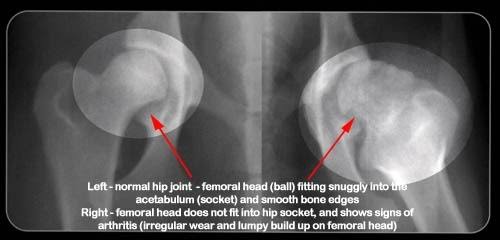Hip Dysplasia is a condition that commonly affects large breed dogs. It occurs when the hip joint doesn’t form correctly through puppyhood. The condition is primarily genetic, but environmental factors such as excess body weight, nutrient intake, and exercise habits through key puppy growth phases can exacerbate it.
Hip dysplasia in dogs can range from mild to severe, with the degree of hip deformity not always indicative of the pain and disability. Hip laxity, or looseness, however, has been shown to be more predictive of disability, and more importantly progression to hip arthritis.
The increased laxity in the hip joint causes more movement within the joint itself. This causes the cartilage to wear and the body also lays down more bone to try and stabilize the joint. The hip joint is now arthritic. In dogs with hip dysplasia, arthritis can set in as early as 1-2 years old.

The hip joint then becomes part of a vicious cycle of worsening symptoms. There is a reluctance to exercise which leads to a loss of muscle mass. Despite the reduction in exercise and lower metabolism (less muscle), the dog is typically still fed the same amount of food leading to weight gain. The increase in body weight leads to an increase in stress on the joints, leading to further degeneration and inflammation. Inflammation causes more pain…and the cycle continues.
The progression of hip dysplasia to hip arthritis is the key component that supplements can help manage.
What Supplements Can I Give My Dog for Hip Dysplasia?
Treatment for the arthritic changes associated with hip dysplasia is best started early in the disease process, as this is when inflammatory mediators and degradative enzymes start to be produced, which go on to complicate the disease process.
Note: if your dog is still a growing puppy it’s important that you speak to your Vet before starting any supplements.
The mainstays in the natural treatment of fully grown dogs with hip dysplasia are:
- Supplements
- Disease Modifying Osteoarthritis Drugs (DMOAD’s)
- Prescription drugs
Supplements
Supplements are not regulated like drugs and it’s easy for companies to take advantage of that. In some cases, only 10% of the actual listed ingredients are active in the product. Look to buy from a trusted brand. Supplements can take up to four weeks before you see the benefits.
Omega 3 Fatty Acids:
Commonly sourced from oily fish, fish oil, or green lipped mussels
Omega 3 fatty acids are a natural anti-inflammatory. They work by shifting the body away from a pro-inflammatory pathway towards an anti-inflammatory pathway. It doesn’t stop the pro-inflammatory pathway entirely but it competes with it, reducing the amount of inflammation.
Traditional NSAID’s (think nurofen, motrin, or voltaren in humans, or metacam in dogs) act on the pro-inflammatory pathway by blocking the end result. Steroids act a little higher up in the pathway. The problem with blocking this pathway, through the use of drugs, is that they also have a negative action on other good things, like the gut wall.
Omega 3 fatty acids don’t have those negative effects. A diet rich in omega 3 fatty acids has been shown to reduce the need for NSAID’s in dogs by ~25%.
Many dry dog foods boast of their Omega 3 contents. Check the source of the Omega 3’s as plant-based oils, such as flaxseed, hemp, coconut, corn, and sesame seed oil contain Omega 3 in the form of Alpha-linolenic Acid (ALA).
ALA needs to be converted to EPA and some dogs don’t have the enzyme to make the conversion. So stick with a good quality EPA / DHA Omega 3 supplement, fish oil, or green-lipped mussels from a trusted brand.
In Australia, the Paw by Blackmores Dermega may be a good option. Alternatively, you may have heard about Antinol. Antinol has taken the good stuff out of the green-lipped mussel (GLM) and put it into a pill. There have been some excellent results to date. Antinol is however Vet only so you’ll need to speak with your Vet.
If you are using whole fish you need to be aware that they can contain heavy metals and toxins. Small fish that only feed on phytoplankton, not fish that eat other fish, are a better option. Look for mackerel (from the Atlantic and not king mackerel), sardines, salmon, or anchovies (source).
Follow this link for a good dosing chart. Always check your food label as good quality foods often have omega 3 fatty acids within the food.
Glucosamine & Chondroitin Sulfate:
Both glucosamine and chondroitin help with the synthesis of cartilage while also reducing inflammatory pathways. Not all glucosamine / chondroitin supplements are created equal, with a lot of questions being raised about the amount of the supplement that makes it into the circulation when ingested orally.
Nutramax laboratories Cosequin DS and Dasuquin would be two of the best glucosamine / chondroitin supplements on the market. In Australia, Cosequin DS is sold by Blackmores as Paw Cosequin DS.
In Australia, 4Cyte may also be a good option. 4Cyte is Vet only and includes GLM, as well as omega 3 fatty acids and magnesium.
In the UK, Yumove by Lintbells is a well-respected product. It’s main ingredients are a combination of glucosamine and green-lipped mussel powder.
Soybean / Avocado Unsaponifiables (ASU):
ASU affects cartilage by enhancing cartilage matrix synthesis and suppresses cartilage matrix degradation. Basically, it helps to regenerate cartilage.
You probably won’t have heard much about it and to be honest neither had until I heard about it from Steven M. Fox, MS, DVM, MBA, Ph.D. through the CCRP program. The reviews of Nutramax’s Dasuquin product also speak for themselves.
ASU is found in Nutramax Dasuquin along with Glucosamine and Chondroitin. You do NOT need an additional Glucosamine / Chondroitin supplement in this case.
Disease Modifying Osteoarthritis Drugs (DMOAD’s)
DMOAD’s work by restoring joint lubrication, relieving inflammation, and renewing the building blocks of healthy cartilage. They are only available as an injectable and therefore regulated by the FDA, which then classifies them as a drug. This means that they’re prescription only and you need to talk to your Vet. Supplements given orally do not fall under FDA regulations.
The two common DMOAD’s are:
Polysulfated glycosaminoglycan’s (PSGAG) – USA: e.g. Adequan
Pentosan polysulfate (PPS) – Australia and Europe: e.g. Cartrophen, Synovan, Pentosan 100, or Zydax
These drugs have a slightly different mechanism of action so you may have superior results with one over the other. Adequan is not available in Australia.
Prescription Drugs
If the above supplements and DMOAD’s aren’t adequately managing your dog’s pain, or your dog has an acute flare, your Vet may discuss medications like NSAID’s or Gabapentin to name a few.
CBD Oil
Anecdotally CBD oil is being hailed by dog owners as an option in the treatment of chronic pain in dogs along with a myriad of other health issues. Over here in Australia, we haven’t caught up with the rest of the world so information and access to CBD Oil is limited. If you would like more information check out this post by Preventive Vet. The article seems to be a well-balanced opinion on CBD oil in dogs.
What Should You Avoid If Your Dog Has Hip Dysplasia?
Excess Bodyweight
If there is laxity associated with hip dysplasia, the amount of damage done to the joint will depend on the amount of force put through that joint. The heavier the dog, the greater the forces will be, and therefore the higher the risk of developing more severe hip dysplasia with progression to arthritis.
Dogs, especially at-risk breeds, should be maintained at a bodyweight on the lower side of ideal. This should start in puppyhood (source).
Excess Calcium in a Puppy
Calcium is one of the few nutrients that, in excess, has been shown to be detrimental to your puppy as they’re growing.
Puppy food has been formulated for specific nutrient and energy needs. Make sure you choose a good quality brand for your breed size, as the nutrient needs for large breeds differ from smaller breeds.
If you’re feeding home-cooked / raw food make sure you understand the energy and nutrient make up of the food. Talk to your Vet if you’re unsure.
Excess Exercise
Puppies raised on slippery floors, or with access to stairs when they’re <3 months old have been shown to have an increased risk of hip dysplasia.
This link provides an excellent description of safe exercise through a dog’s lifespan.
Conclusion
Hip dysplasia is a developmental condition that often progresses to arthritis. Dogs as young as 1-2yrs old have demonstrated arthritic changes in their hip joints.
Supplements have been shown to be very effective in the ongoing management of pain and dysfunction associated with arthritic changes.
It is important to talk to your Vet about supplementation, especially if your dog is not fully grown. Work with your Vet to ensure the supplement is safe for the age of your dog.
If you would like to read more about hip dysplasia treatment, check out my article here.

